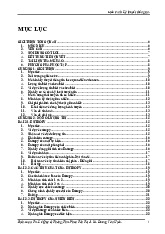





Preview text:
Spectrum of M-FSK f ∆ ⋯ f f f f f f 1 2 3 M 1 − M
In M -FSK, only one carrier is active in any given symbol duration
to carry log M bits. This is why it is not a spectral-efficient 2 modulation scheme.
Why not using all the carriers to carry information at the same time
since they are orthogonal? This leads to OFDM (orthogonal
frequency-division multiplexing) technique.
EE456 – Digital Communications Ha H. Nguyen
OFDM (Orthogonal Frequency-Division Multiplexing) 1 f ∆ = TN ⋯ f f f f f f 1 2 3 N 1 − N N
Bandwidth W ≈ N ⋅ f ∆ = TN
In OFDM the spectrum (frequency) is divided into overlapping but
orthogonal subcarriers. Each sub-carrier is independently modulated
by M -QAM. The minimum subcarrier separation is 1/TN, where TN is the OFDM symbol length.
OFDM can be simply looked upon as a combination of amplitude,
phase and frequency modulation techniques.
EE456 – Digital Communications Ha H. Nguyen
Communication Services using OFDM Wireless Wireline ADSL and VDSL broadband access
IEEE 802.11a, g, n (WiFi) Wireless LANs via POTS copper wiring MoCA (Multi-media over Coax
IEEE 802.15.3a Ultra Wideband (UWB) Wireless PAN Alliance) home networking
IEEE 802.16d, e (WiMAX), WiBro, PLC (Power Line Communication) and HiperMAN Wireless MANs IEEE 802.20 Mobile Broadband Wireless Access (MBWA)
DVB (Digital Video Broadcast) terrestrial TV
systems: DVB -T, DVB -H, T-DMB, and ISDB-T
DAB (Digital Audio Broadcast) systems:
EUREKA 147, Digital Radio Mondiale, HD Radio, T-DMB, and ISDB-TSB Flash-OFDM cellular systems
3GPP UMTS & 3GPP@ LTE (Long-Term Evolution), and 4G
OFDM is spectrally efficient, tolerates environments with
high RF interference, works well in harsh multi-path
environments and can be elegantly implemented with IFFT/FFT modules.
EE456 – Digital Communications Ha H. Nguyen Implementation of OFDM X [0] [ x 0] sin (2π f t c ) 1 "" X [1] [ x 1] x (t) I ' # + r bits/sec s(t) b X $ # ! / , % - " &' ( x (t) Q ' * ) + X [N −1] [ x N −1] cos (2π f tc ) sin (2π f t c ) [ y 0] Y[0] & ' [ y 1] Y[1] . 0 ) + 2 $ # [ y n] % Y r(t) " " ! 3 * , / " ( '& 4 " * ) & ' . " + [ y N −1] Y[ N −1] cos (2π f t c )
EE456 – Digital Communications Ha H. Nguyen
Multipath Problem in High-Speed Wireless Transmission 8 9 6 : ; < B ?< ? B : 9 D E E C 5 6 7 8 9 6 : ; < = : > <; < ? ? @A B < ; C C
Example: Consider the symbol rate of 106 symbols/sec ⇒ The receiver expects a
specific symbol within a window of 1 µs. If multi-path delays the signal by more than
1 µs (easily happen in real propagation environment), then the receiver will also
receive the symbol in the next symbol period, causing inter-symbol-interference (ISI),
hence severe performance degradation.
EE456 – Digital Communications Ha H. Nguyen
How Does Cyclic Prefix Work in OFDM
Append last µ symbols to the front [ x N − µ], [ x N − µ +1], − µ − µ + ⋯ − ⋯⋯⋯ − − ⋯, [ x N −1] [ x 0], [ x 1], [ x 2], , [ x N µ 1] [ x N ], [ x N 1], , [ x N 1]
Cyclic prefix (CP) of length µ
Original signal sequence of length N CP [ x 0],⋯, [ x N −1] CP [ x 0],⋯, [ x N −1] CP [ x 0],⋯, [ x N −1] CP CP Data block CP Data block CP Data block ISI [ y 0],⋯, [ y N −1] ISI [ y 0],⋯, [ y N −1] ISI [ y 0],⋯, [ y N −1] ⋯ ⋯ µ N µ N µ N
An OFDM symbol is basically a super-symbol obtained by multiplexing many
M -QAM symbols in a complicated manner. The length of a super-symbol (TN )
becomes longer and hence more resistent to multipath effect.
One can also use zero padding to create a guard interval between consecutive
OFDM symbols, hence avoiding ISI.
EE456 – Digital Communications Ha H. Nguyen




